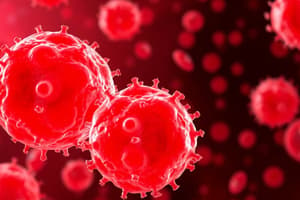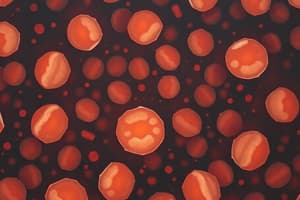Podcast
Questions and Answers
What is the most common type of leukemia in adults in western countries?
What is the most common type of leukemia in adults in western countries?
- Chronic myeloid leukemia (CML)
- Acute lymphoblastic leukemia (ALL)
- Chronic lymphocytic leukemia (CLL) (correct)
- Acute myeloid leukemia (AML)
Which of the following laboratory tests is NOT specific for diagnosing chronic lymphocytic leukemia (CLL)?
Which of the following laboratory tests is NOT specific for diagnosing chronic lymphocytic leukemia (CLL)?
- Clinical biochemical tests (correct)
- Flow cytometry
- Complete blood count (CBC)
- Bone marrow biopsy
What is a hallmark feature of chronic myeloid leukemia (CML)?
What is a hallmark feature of chronic myeloid leukemia (CML)?
- Abnormal T cell proliferation
- Decreased levels of uric acid
- Increased numbers of granulocytes (correct)
- Presence of Reed-Sternberg cells
What characterizes acute leukemias in terms of white blood cell maturity?
What characterizes acute leukemias in terms of white blood cell maturity?
What is typically used to diagnose Hodgkin lymphoma?
What is typically used to diagnose Hodgkin lymphoma?
Which of the following is NOT a feature commonly associated with acute lymphocytic leukemia (ALL)?
Which of the following is NOT a feature commonly associated with acute lymphocytic leukemia (ALL)?
Chronic lymphocytic leukemia (CLL) mainly involves which type of cells?
Chronic lymphocytic leukemia (CLL) mainly involves which type of cells?
Which type of blood cell is increased in chronic leukemias?
Which type of blood cell is increased in chronic leukemias?
What feature distinguishes non-Hodgkin lymphoma from Hodgkin lymphoma?
What feature distinguishes non-Hodgkin lymphoma from Hodgkin lymphoma?
What is typically used to diagnose acute myeloid leukemia (AML)?
What is typically used to diagnose acute myeloid leukemia (AML)?
Which of the following is a key diagnostic characteristic of chronic myeloid leukemia (CML)?
Which of the following is a key diagnostic characteristic of chronic myeloid leukemia (CML)?
In the case of increased lactate dehydrogenase (LDH), which condition is most likely present?
In the case of increased lactate dehydrogenase (LDH), which condition is most likely present?
What occurs in early-stage lymphomas with regard to hematology?
What occurs in early-stage lymphomas with regard to hematology?
Which of the following is an essential component of the complete blood count (CBC) useful for leukemia diagnosis?
Which of the following is an essential component of the complete blood count (CBC) useful for leukemia diagnosis?
What is a characteristic of chronic leukemias as opposed to acute leukemias?
What is a characteristic of chronic leukemias as opposed to acute leukemias?
What is the primary symptom indicating the presence of Hodgkin lymphoma?
What is the primary symptom indicating the presence of Hodgkin lymphoma?
Which of the following statements about white blood cell disorders is accurate?
Which of the following statements about white blood cell disorders is accurate?
Which complication is often associated with acute lymphoblastic leukemia (ALL)?
Which complication is often associated with acute lymphoblastic leukemia (ALL)?
What type of cells are primarily affected by acute myeloid leukemia (AML)?
What type of cells are primarily affected by acute myeloid leukemia (AML)?
Which blood disorder primarily involves anemia as a primary abnormality?
Which blood disorder primarily involves anemia as a primary abnormality?
What is a primary consequence of iron deficiency in red blood cells?
What is a primary consequence of iron deficiency in red blood cells?
Which of the following statements about hemoglobin is incorrect?
Which of the following statements about hemoglobin is incorrect?
Which of the following parameters is NOT included in a Complete Blood Count (CBC)?
Which of the following parameters is NOT included in a Complete Blood Count (CBC)?
In anemia classification, what does hypochromic indicate?
In anemia classification, what does hypochromic indicate?
What role does transferrin play in iron metabolism?
What role does transferrin play in iron metabolism?
Which symptom is NOT typically associated with anemia?
Which symptom is NOT typically associated with anemia?
What is the primary function of heme in red blood cells?
What is the primary function of heme in red blood cells?
What is indicated by an increased mean corpuscular volume (MCV) in a patient?
What is indicated by an increased mean corpuscular volume (MCV) in a patient?
Which organ is primarily responsible for the storage of ferritin?
Which organ is primarily responsible for the storage of ferritin?
Which of the following is a function of red blood cells (RBCs)?
Which of the following is a function of red blood cells (RBCs)?
What is the primary cause of pernicious anemia?
What is the primary cause of pernicious anemia?
What laboratory finding is typically associated with iron-deficiency anemia?
What laboratory finding is typically associated with iron-deficiency anemia?
What is a common feature of thalassemia?
What is a common feature of thalassemia?
In sickle cell anemia, what primarily causes the chronic anemia?
In sickle cell anemia, what primarily causes the chronic anemia?
Which of the following conditions is classified as a normocytic, normochromic anemia?
Which of the following conditions is classified as a normocytic, normochromic anemia?
What is the result of increased hemoglobin breakdown?
What is the result of increased hemoglobin breakdown?
Which laboratory finding would likely indicate pernicious anemia?
Which laboratory finding would likely indicate pernicious anemia?
What characterizes sickle cell disease at the molecular level?
What characterizes sickle cell disease at the molecular level?
What is the relationship between chronic diseases and anemia of chronic disease?
What is the relationship between chronic diseases and anemia of chronic disease?
Which laboratory test is essential for diagnosing thalassemia?
Which laboratory test is essential for diagnosing thalassemia?
Flashcards
Leukemia
Leukemia
A type of cancer affecting white blood cells, primarily originating in bone marrow and blood.
Lymphoma
Lymphoma
Malignant cancers affecting lymphatic tissues, crucial for the immune system.
Acute Leukemia
Acute Leukemia
A form of leukemia involving undifferentiated white blood cells (blasts).
Chronic Leukemia
Chronic Leukemia
Signup and view all the flashcards
Acute Lymphocytic Leukemia (ALL)
Acute Lymphocytic Leukemia (ALL)
Signup and view all the flashcards
Acute Myeloid Leukemia (AML)
Acute Myeloid Leukemia (AML)
Signup and view all the flashcards
Chronic Lymphocytic Leukemia (CLL)
Chronic Lymphocytic Leukemia (CLL)
Signup and view all the flashcards
Chronic Myeloid Leukemia (CML)
Chronic Myeloid Leukemia (CML)
Signup and view all the flashcards
Hodgkin Lymphoma
Hodgkin Lymphoma
Signup and view all the flashcards
Non-Hodgkin Lymphoma
Non-Hodgkin Lymphoma
Signup and view all the flashcards
Hematopoietic Stem Cell
Hematopoietic Stem Cell
Signup and view all the flashcards
Hemoglobin
Hemoglobin
Signup and view all the flashcards
Iron
Iron
Signup and view all the flashcards
Anemia
Anemia
Signup and view all the flashcards
Mean Corpuscular Volume (MCV)
Mean Corpuscular Volume (MCV)
Signup and view all the flashcards
Iron-Deficiency Anemia
Iron-Deficiency Anemia
Signup and view all the flashcards
Disseminated Intravascular Coagulation (DIC)
Disseminated Intravascular Coagulation (DIC)
Signup and view all the flashcards
Study Notes
White Blood Cell Disorders
- Leukemia and lymphoma are the two primary categories of white blood cell diseases, representing significant health concerns in hematology.
- Leukemia primarily affects the bone marrow and blood, leading to an overproduction of abnormal white blood cells that disrupt normal blood function.
- In contrast, lymphoma predominantly impacts lymphoid tissues, which are crucial components of the immune system.
- All blood cell types, including red blood cells, white blood cells, and platelets, originate from a common source known as the hematopoietic stem cell located in the bone marrow.
- Leukemia and lymphoma represent abnormal conditions that can involve either myeloid or lymphoid cells, resulting in malignancies that require careful diagnosis and treatment.
Leukemias
- Leukemias are classified as malignant diseases that invade and disrupt the normal function of the bone marrow and bloodstream, leading to profound hematological abnormalities.
- In leukemia, the body produces abnormal, nonfunctional white blood cells that enter the circulation, compromising the immune response and overall health.
- Acute Leukemias
- Characterized by the presence of undifferentiated white blood cells, often referred to as blasts, which are typically seen in circulation.
- Chronic Leukemias
- These types involve immature white blood cells that are also found in the circulation, but these cells often retain some functional capabilities.
Types of Leukemias
- Acute Lymphocytic Leukemia (ALL)
- This type is notably the most prevalent leukemia found in children and adolescents, highlighting the need for early diagnosis and treatment.
- Lymphoid precursors in the bone marrow proliferate uncontrollably, leading to a significant increase in blast cells.
- Many patients with ALL experience disseminated intravascular coagulation (DIC), a serious complication that necessitates prompt medical attention.
- Laboratory Considerations:
- Findings may include neutropenia (low white blood cells), anemia (low red blood cells), and thrombocytopenia (low platelets).
- Increased levels of lactate dehydrogenase (LDH), which indicates tissue breakdown, and uric acid levels are also common.
- Acute Myeloid Leukemia (AML)
- This type is characterized by the accumulation of abnormal myeloid cell precursors in the bone marrow and peripheral blood.
- Abnormal cells can also build up in vital organs such as the spleen and liver, causing additional complications.
- Laboratory Considerations:
- Similar to ALL, patients may present with neutropenia, anemia, and thrombocytopenia.
- Elevated LDH and uric acid levels are common, reflecting high cell turnover.
- A definitive diagnosis typically requires a bone marrow biopsy to identify the specific type of leukemia involved.
- Chronic Lymphocytic Leukemia (CLL)
- CLL is the most common form of leukemia in adults and often presents with small, nonfunctional lymphocytes in the bloodstream.
- This type of leukemia can be insidious, with many individuals remaining asymptomatic for several years before diagnosis.
- Laboratory Considerations:
- No specific clinical biochemical tests exist to definitively diagnose CLL, making clinical judgment paramount.
- Diagnostic evaluation may involve bone marrow biopsy and flow cytometry to differentiate CLL from other hematological malignancies.
- Most cases are characterized by the presence of abnormal B lymphocytes, which play a critical role in immune function.
- Chronic Myeloid Leukemia (CML)
- In CML, there is a significant increase in the numbers of granulocytes present in the bone marrow, which can lead to splenomegaly and other symptoms.
- This type accounts for approximately 20% of all adult leukemias, emphasizing a need for awareness and screening.
- Laboratory Considerations:
- Elevated uric acid levels suggest increased cellular turnover and potential complications.
- The presence of the Philadelphia (PH 1) chromosome translocation can serve as a diagnostic hallmark of this disease.
Lymphomas
- Lymphomas represent a form of malignancy that primarily affects the lymphatic system, which plays a vital role in the body’s immune response.
- These cancers can originate from abnormal B or T cells, highlighting the diversity of immune cell involvement in lymphomas.
- Hodgkin Lymphoma
- This form of lymphoma is characterized by the presence of atypical B cells known as Reed-Sternberg cells within lymph node biopies.
- One of the earliest symptoms is often the appearance of a single painless lymph node, typically located in the cervical region, indicating lymph node enlargement.
- Non-Hodgkin Lymphoma
- This type can arise from either abnormal B or T cells and is significantly more common than Hodgkin lymphoma, with a prevalence that is about eight times greater.
- Symptoms often include the enlargement of peripheral lymph nodes, which can lead to noticeable swelling and discomfort.
- Unlike Hodgkin lymphoma, peripheral blood tests generally do not provide much useful information for diagnosing non-Hodgkin lymphoma, necessitating more specific diagnostic measures.
Lymphomas and Useful Biochemical Tests
- In the early stages, lymphomas may present with normal results in hematology and clinical biochemistry, which can complicate timely diagnosis.
- To accurately differentiate between types of lymphoma, lymph node or bone marrow biopsies are essential, enabling clinicians to ascertain the specific characteristics of the disease.
- In Hodgkin lymphoma, the identification of Reed-Sternberg cells is critical for diagnosis.
Clinical Importance of WBC count with Differential - Leukemia and Lymphoma
- White blood cell (WBC) counts, along with a differential cell count, are integral components of the Complete Blood Count (CBC).
- The initial diagnosis of leukemia often relies heavily on an abnormal WBC count and differential, allowing for timely intervention.
- These counts help classify the subtype of leukemia, guiding treatment strategies and prognostic assessments.
- Monitoring the disease progression, detecting potential complications, and adjusting treatment regimens are all facilitated by regular WBC count assessments.
- Furthermore, evaluating the response to therapy and identifying signs of recurrence can be effectively achieved through WBC differential counts.
Red Blood Cells
- Anemias refer to conditions where there is a deficiency in red blood cells (RBCs) or in hemoglobin within the blood, leading to various health complications.
- Common symptoms associated with anemia include:
- Weakness, which can profoundly impact quality of life.
- Dizziness, which might lead to safety concerns if it impacts balance.
- Pale mucous membranes, a physical indicator of possible underlying illnesses.
- Lightheadedness, especially during physical activities, indicative of reduced oxygen transport.
- Tachycardia, or increased heart rate, as the body attempts to compensate for lower oxygen levels.
- The classification of anemias can be based on:
- The size and shape of red blood cells, which are categorized as microcytic, normocytic, or macrocytic based on their dimensions.
- The amount and concentration of hemoglobin, classified into hypochromic (low), normochromic (normal), or hyperchromic (high) based on coloration.
Anemia - Basic Concepts
- Hemoglobin: A complex globular protein that is essential for transporting oxygen (O2) and carbon dioxide (CO2) between the lungs and tissues.
- Iron: An essential element that serves as a critical component of hemoglobin, necessary for its oxygen-binding capacity.
- The absorption of iron occurs in the intestine, regulated by a negative feedback loop to maintain balance.
- Once absorbed, iron is transported to the liver, where it plays a crucial role in heme synthesis—a vital process for red blood cell production.
- Transferrin is a clinically important protein that transports iron in the blood, maintaining iron availability for hemoglobin synthesis.
- Iron is stored in the body primarily as ferritin, with significant deposits found in the liver, spleen, and bone marrow; these reserves are mobilized as needed.
- Heme: A critical molecule composed of a porphyrin ring with an iron atom at its center, responsible for the red color of blood.
- The oxygen molecule binds to the iron atom in the heme group, facilitating oxygen transport in the bloodstream.
- In the bone marrow, the majority of heme synthesis occurs during the development of red blood cells.
- The heme produced by red blood cells is utilized to create hemoglobin, the principal component of RBCs.
- Heme is also present in cytochromes, which are essential for cellular energy production within mitochondria.
Consequences of iron deficiency
- Iron deficiency leads to decreased levels of iron, resulting in several physiological changes:
- Red blood cells may become smaller and take on a microcytic appearance under the microscope.
- A decrease in the amount of hemoglobin results in hypochromia, where red blood cells appear paler than normal.
- The functionality of cytochromes in mitochondria may be compromised, affecting cellular energy metabolism.
Anemia and CBCs
- The Complete Blood Count (CBC) includes critical parameters such as RBC or erythrocyte count, hemoglobin concentration, hematocrit levels, and various RBC indices (MCV, MCH, MCHC, RDW).
- Mean Corpuscular Volume (MCV): This parameter indicates the average size of red blood cells, aiding in the classification of anemias based on cell morphology.
- Mean Corpuscular Hemoglobin (MCH): This value reflects the average amount of hemoglobin present in each individual red blood cell.
- Mean Corpuscular Hemoglobin Concentration (MCHC): This metric represents the average concentration of hemoglobin within a given volume of red blood cells.
- Red Cell Distribution Width (RDW): This index indicates the degree of variation in red blood cell size, known as anisocytosis, which can be a key factor in diagnosing specific types of anemia.
Anemias and Diagnostic Tests
- Iron-Deficiency Anemia:
- Characterized by an insufficiency of iron in the blood; it is the most common type of microcytic anemia.
- Laboratory considerations include:
- Low hemoglobin levels, decreased hematocrit, and reduced MCH and MCHC values, while RDW is often elevated.
- Additional tests may include measuring iron levels, Total Iron Binding Capacity (TIBC), and ferritin levels to assess iron stores.
- Pernicious Anemia:
- This condition arises from a deficiency of vitamin B12, which is often due to an autoimmune disease leading to gastric atrophy.
- Laboratory considerations typically reveal:
- Significantly increased LDH levels, which may indicate hemolysis or tissue breakdown.
- Elevated indirect (unconjugated) bilirubin values may also be observed, indicating compromised liver function.
- Sickle Cell Anemia:
- This hereditary blood disorder is characterized by a mutation in the hemoglobin gene, leading to the formation of sickle-shaped red blood cells.
- Laboratory considerations include specialized tests such as sickling tests and hemoglobin electrophoresis to confirm the diagnosis.
- Thalassemia:
- An inherited group of blood disorders characterized by mutations in genes responsible for alpha or beta-globin chain synthesis in hemoglobin.
- Laboratory considerations for thalassemia include:
- Reduced hemoglobin levels and a decrease in RBC count and size (MCV).
- Hemoglobin electrophoresis may be used to identify abnormal hemoglobin types.
- Genetic testing can confirm specific genetic mutations associated with thalassemia.
- Anemia of Chronic Diseases:
- This category of anemia is typically classified as normocytic and normochromic and is associated with long-standing chronic illnesses such as rheumatoid arthritis or chronic kidney disease.
- Laboratory considerations for this type of anemia may include:
- Decreased overall red blood cell count, which can contribute to symptoms of anemia.
- Lowered iron levels in the blood, indicating potential sequestration by the reticuloendothelial system.
- Reduced erythropoietin production as a response to chronic inflammation, ultimately leading to decreased RBC production.
- Additionally, a shortened red blood cell lifespan, typically ranging from 70 to 80 days, can be observed.
Breakdown of Hemoglobin
- The increased breakdown of hemoglobin results in the formation of bilirubin, a yellow compound that can indicate cell turnover when elevated in the blood.
- As hemoglobin is broken down, unconjugated bilirubin levels in plasma may increase, reflecting the liver's workload in processing these byproducts.
- Bilirubin is transported to the liver for conjugation by albumin, a key transport protein in the blood.
- Once in the liver, unconjugated bilirubin is converted into conjugated bilirubin, which is water-soluble, allowing for easier excretion.
- Conjugated bilirubin is ultimately excreted into the bile, facilitating the elimination of waste products from the body.
Studying That Suits You
Use AI to generate personalized quizzes and flashcards to suit your learning preferences.




